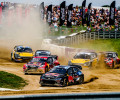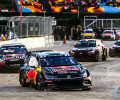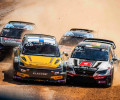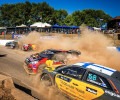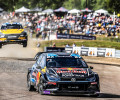Winning ways
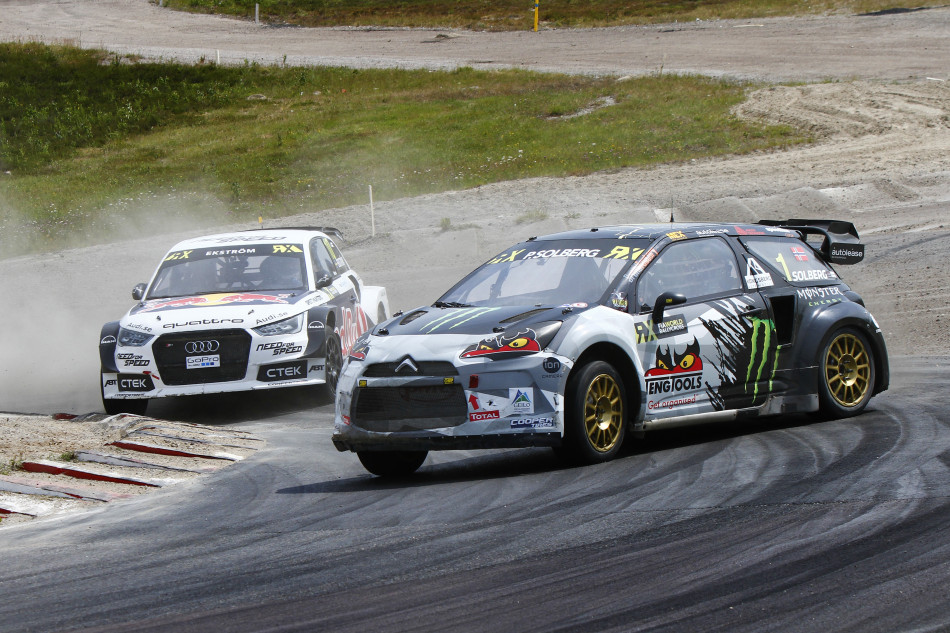
Mattias Ekström and Petter Solberg are arguably the two fastest drivers in the 2016 FIA World Rallycross Championship. But watch them take certain corners and you could be forgiven for thinking they are racing in different competitions with disparate machinery.
Solberg is renowned for his trademark ‘ at out’ sideways style, while Ekström is known for being very neat and tidy, always using the circuit racing ‘line’ in an attempt to achieve the best lap time. That can often mean that two cars racing in close proximity are at totally opposing angles of trajectory, as seen at the Sachs Curve at Hockenheim, Germany, Paddock Bend at Lydden Hill, UK, and the Joker Lap in Hell, Norway, for example.
So how can two drivers with opposing styles, taking different lines into the same corner, be equally fast on track (they were first and second in the championship as of September 1, 2016)?
Much of this is because, although strictly controlled, the technical regulations for the World RX series are designed to embrace engineering innovation and diversity (see Technology panel, p65). The competition is close, very close, thanks in no small part to rules that allow engineers to provide cars in which drivers of widely varying driving styles can be equally competitive.
As such, World RX is rife with high-quality drivers who have switched disciplines to take part in the series, with Solberg and Sébastien Loeb from rallying competing alongside Ekström and Timmy Hansen, who previously plied their trade in circuit racing.
“I like to drive with clean lines and close to the grip limit of the tyres on both the front and rear axle,” says Ekström. “A tiny bit of oversteer makes me fast. I think fast, long tarmac corners show who drives more clean, or more sideways. Lydden Hill is a good place to show that in general.”
The Swede believes that as a driver, racing a competitor who is using a totally opposing style can be a challenge. “It’s certainly di cult to follow, especially closely, as they set the mid-corner speed di erently depending on how they drive,” he explains.
Solberg’s style is quite the opposite of Ekström’s and his sideways antics are a firm favourite with the fans. However, the former FIA World Rally Champion and two-time World Rallycross Champion says his car’s ‘softer’ set-up, allied to his own driving style, is designed to suit the requirements of rallycross rather than a perceived love of travelling sideways.
“I have an inline [longitudinal] engine in my car, and some have transverse. It’s a bit like when I was in the WRC trying to compare the Subaru Impreza to the Citroën Xsara, it’s just a di erent philosophy with a di erent chassis,” he says. “I like to drive with a tiny bit of understeer, with good reaction from the front. I don’t like an oversteering car – I like it to be responsive and precise at the front so it turns in well. I can drive faster on tarmac with a sti er car, but it’s always a balance. When you have loose surfaces, and because the starts are so important in rallycross, it’s best for us to go softer. It’s about the clock, not about how clean it [the driving] looks.”
Ekström believes that the tyres used in World RX (control crossply Cooper Tyres) play their part as well as the fundamental car set-up in allowing di erent driving styles. “The tyres are very forgiving and in rallycross tyre management is relatively small compared to other series. We have eight dry tyres for a weekend, which is a lot when you consider how few kilometres we do on them. That means there is zero tyre wear on some tracks, but on high-wear tracks it can be di erent. The similar lap times with di erent driving styles comes from similar power and grip of the tyres. The question is how long can you drive fast and make your tyres last.”
The Swede, who uses a stiffer chassis with less feedback for the driver, says he might struggle with a softer set-up like Solberg’s and vice-versa. “I think they [Solberg and similar drivers] would struggle to drive my car a bit to start with, and I doubt I would be fast in his soft ‘boat’,” he quips.
ENCOURAGING COMPETITION
The absence of strict homologation processes in the World RX regulations (aside from areas like the ECU hardware and software, to combat any illegal use of electronic driver aids) also gives teams freedom to re-engineer components race-by-race. If something breaks, they can create a better version.
Solberg believes this is key to the success of the championship. “That’s a big part of the fun,” he says. “With rallying it’s very di erent, but here if somebody is faster than you in one race you can do something for the next race.”
The reigning champion also thinks engineering diversity and a range of driving styles is one of the big appeals of World RX. “Rallycross is old-fashioned in some ways, but it’s very good for competition,” he explains. “If everybody drives exactly the same with the same set-up then it would be boring. You drive for the spectators and the show. In rallycross there will always be drivers from di erent sports to ensure di erent driving styles.”
Kenneth Hansen, the sport’s most successful driver with 14 FIA European titles to his name and now team principal of reigning World RX champions Peugeot-Hansen, says rallycross allows for driving styles that perhaps shouldn’t work.
“It’s an interesting point, as the di erent ways people drive shouldn’t all work,” he says. “The clean style should be the way, but in rallycross everything is changing all the time – the level of grip in each corner, on each lap. You can gain time with a sti er racing car style, but it can also be that the more sideways rally way can gain in other places. That makes it quite interesting because these two styles don’t follow exactly the same speed around the track, so it opens the way a little for overtaking and makes it good to watch.”
Hansen is keen that the technical regulations should evolve to maintain traditional values without excluding current or potential participants. “I think it’s good if we can balance the regulations so it’s not too easy for a manufacturer to develop a very good car. It should also be that privateers can still build good cars like in the past and can compete at a good level.
“It will be good if we can keep it that way – if we had full homologation it could be expensive and close doors for many people. The top might stay the same but for the grades down, at European and national level, that would be complicated and not so good.”
Ultimately, competitors and fans alike are winners from the current technical regulations in World RX, which provide exciting racing, interesting engineering and are attracting an in ux of high-pro le drivers, teams and manufacturers.
TECH FREEDOM
World RX regulations are helping to ensure that rallycross retains its kudos of being a ‘raw’ sport, not only because the 600bhp Supercars spit flames due to their aggressive anti-lag systems – and race door-to-door in a frenzy of quick-fire sideways action – but because the rules allow for innovation.
The technical rules are structured in such a way that privateers and major teams (now often manufacturer- supported) can compete side-by-side. Part of this is the freedom to design in-house, with no requirement to homologate specific parts, as is the case in world rallying, for example.
Supercar constructors have the freedom to run the engine and transmission either transversely or longitudinally in the engine bay and modify the chassis accordingly, to change a chassis’ balance and centre of gravity. At each corner of the car, while other disciplines require items like suspension to follow a specific directive, World RX is more open.
In the 2016 FIA World Rallycross Championship there are a number of engineering interpretations prompted by what designers believe to be the best solution to the constant compromise of competing on both sealed and unsealed surfaces in the space of a kilometre lap.
Some cars, such as the Team Peugeot-Hansen Peugeot 208 WRX, follow a philosophy more akin to WRC and use McPherson suspension all round, with a damper, upright and lower ‘A-arm’. Others, like the new-for-2016 Ford Focus RS RX, use a double- wishbone design more akin to Supercars of previous eras. Münnich Motorsport’s SEAT Ibiza employs a McPherson front and double-wishbone rear to try to reach the optimum set-up.
The development of cars is constantly evolving and, as such, many adapt their methods year-on-year. Two-time champion Petter Solberg had run his private Citroën DS3 with double- wishbone suspension all round, but has switched to a McPherson design for 2016. While the M-Sport-built Focus RS RX has been designed using double- wishbone suspension, when its predecessor, the Fiesta, used McPherson similar to its WRC cousin.
“There is more freedom compared to projects such as the WRC,” says Tim Jackson, chief engineer for rallycross at M-Sport. “Because we’re not limited, like in other formulas where you have to run a certain type of suspension, you have a bit more freedom. We looked at various options and determined that this [double-wishbone] was the best package for us, but there are several solutions people use.”
A double-wishbone suspension is better for some teams, as the non-OE layout allows engineers to design all the required suspension geometry into the chassis from the offset, sometimes more easily than with McPherson.
The engine (orientation and general design) and suspension are the big items for innovation, but freedom also extends to the drivetrain; di erent gearbox manufacturers, whether to use a centre di erential or not, di erential type and set-up, and so on.
The stability of the technical rules plays a key role in managing costs, despite the freedom of the engineering. The rules do include restrictions on materials that can be used, and the amount of alteration allowed to certain areas of the chassis. All World RX teams have a seat in the FIA Rallycross Technical Working Group, which keeps a watchful eye on technologies that could a ect costs, and teams are also represented in the FIA’s O -Road commission to play a part in that rule-making process.
This article comes from FIA Magazine Auto #16. You can read the full magazine here.

 Facebook
Facebook Twitter
Twitter